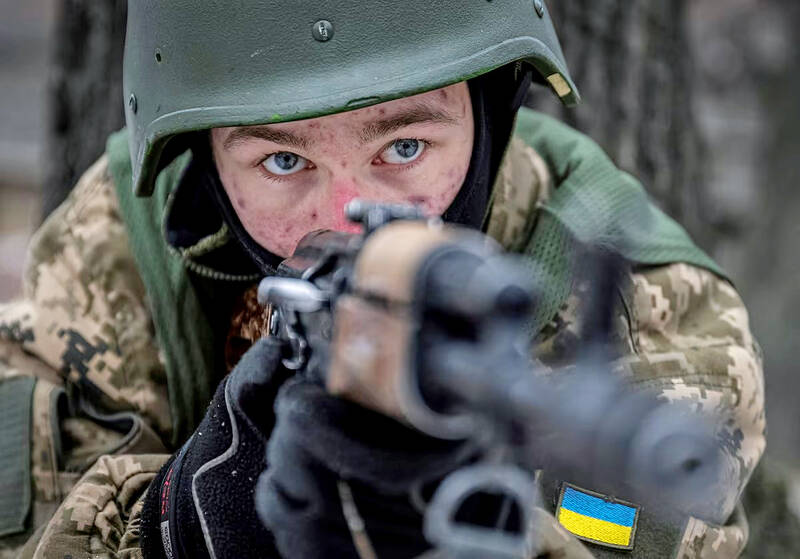Two key advisers to former US president Donald Trump have presented him with a plan to end Russia’s war in Ukraine — if he wins November’s presidential election — that involves telling Ukraine it would only get more US weapons if it enters into peace talks.
Washington would at the same time warn Moscow that any refusal to negotiate would result in increased US support for Ukraine, retired US Lieutenant General Keith Kellogg, one of Trump’s national security advisers, said in an interview.
Under the plan drawn up by Kellogg and Fred Fleitz, who both served as chiefs of staff in Trump’s National Security Council during his 2017-2021 presidency, there would be a ceasefire based on prevailing battle lines during peace talks.

Photo: REUTERS
They have presented their strategy to Trump, who responded favorably, Fleitz said.
“I’m not claiming he agreed with it or agreed with every word of it, but we were pleased to get the feedback we did,” he said.
However, Trump spokesman Steven Cheung said only statements made by Trump or authorized members of his campaign should be deemed official.
The strategy outlined by Kellogg and Fleitz is the most detailed plan yet by associates of Trump, who has said he could quickly settle the war in Ukraine if he beats US President Joe Biden in the Nov. 5 election, though he has not discussed specifics.
The proposal would mark a big shift in the US position on the war and would face opposition from European allies and within Trump’s Republican Party.
The Kremlin said that any peace plan proposed by a possible future Trump administration would have to reflect the reality on the ground, but that Russian President Vladimir Putin remained open to talks.
“The value of any plan lies in the nuances and in taking into account the real state of affairs on the ground,” Kremlin spokesman Dmitry Peskov said.
“President Putin has repeatedly said that Russia has been and remains open to negotiations, taking into account the real state of affairs on the ground,” he said. “We remain open to negotiations.”
The Ukrainian Ministry of Foreign Affairs did not respond to requests for comment on the plan.
The core elements of the plan were outlined in a publicly available research paper published by the “America First Policy Institute,” a Trump-friendly think tank where Kellogg and Fleitz hold leadership positions.
Kellogg said it would be crucial to get Russia and Ukraine to the negotiating table quickly if Trump wins the election.
“We tell the Ukrainians: ‘You’ve got to come to the table, and if you don’t come to the table, support from the United States will dry up,’” he said. “And you tell Putin: ‘He’s got to come to the table and if you don’t come to the table, then we’ll give Ukrainians everything they need to kill you in the field.’”
Moscow would also be coaxed to the table with the promise of NATO membership for Ukraine being put off for an extended period, the research paper said.
Fleitz said Ukraine need not formally cede territory to Russia under their plan.
Still, Ukraine was unlikely to regain effective control of all its territory in the near term, he added.
“Our concern is that this has become a war of attrition that’s going to kill a whole generation of young men,” he said.
A lasting peace in Ukraine would require additional security guarantees for Ukraine, the pair said.
Fleitz added that “arming Ukraine to the teeth” was likely to be a key element of that.
“President Trump has repeatedly stated that a top priority in his second term will be to quickly negotiate an end to the Russia-Ukraine war,” Cheung said. “The war between Russia and Ukraine never would have happened if Donald J. Trump were president. So sad.”
The Biden campaign said Trump is not interested in standing up to Putin.
“Donald Trump heaps praise on Vladimir Putin every chance he gets, and he’s made clear he won’t stand against Putin or stand up for democracy,” campaign spokesman James Singer said.

Kehinde Sanni spends his days smoothing out dents and repainting scratched bumpers in a modest autobody shop in Lagos. He has never left Nigeria, yet he speaks glowingly of Burkina Faso military leader Ibrahim Traore. “Nigeria needs someone like Ibrahim Traore of Burkina Faso. He is doing well for his country,” Sanni said. His admiration is shaped by a steady stream of viral videos, memes and social media posts — many misleading or outright false — portraying Traore as a fearless reformer who defied Western powers and reclaimed his country’s dignity. The Burkinabe strongman swept into power following a coup in September 2022

‘FRAGMENTING’: British politics have for a long time been dominated by the Labor Party and the Tories, but polls suggest that Reform now poses a significant challenge Hard-right upstarts Reform UK snatched a parliamentary seat from British Prime Minister Keir Starmer’s Labor Party yesterday in local elections that dealt a blow to the UK’s two establishment parties. Reform, led by anti-immigrant firebrand Nigel Farage, won the by-election in Runcorn and Helsby in northwest England by just six votes, as it picked up gains in other localities, including one mayoralty. The group’s strong showing continues momentum it built up at last year’s general election and appears to confirm a trend that the UK is entering an era of multi-party politics. “For the movement, for the party it’s a very, very big

ENTERTAINMENT: Rio officials have a history of organizing massive concerts on Copacabana Beach, with Madonna’s show drawing about 1.6 million fans last year Lady Gaga on Saturday night gave a free concert in front of 2 million fans who poured onto Copacabana Beach in Rio de Janeiro for the biggest show of her career. “Tonight, we’re making history... Thank you for making history with me,” Lady Gaga told a screaming crowd. The Mother Monster, as she is known, started the show at about 10:10pm local time with her 2011 song Bloody Mary. Cries of joy rose from the tightly packed fans who sang and danced shoulder-to-shoulder on the vast stretch of sand. Concert organizers said 2.1 million people attended the show. Lady Gaga

SUPPORT: The Australian prime minister promised to back Kyiv against Russia’s invasion, saying: ‘That’s my government’s position. It was yesterday. It still is’ Left-leaning Australian Prime Minister Anthony Albanese yesterday basked in his landslide election win, promising a “disciplined, orderly” government to confront cost-of-living pain and tariff turmoil. People clapped as the 62-year-old and his fiancee, Jodie Haydon, who visited his old inner Sydney haunt, Cafe Italia, surrounded by a crowd of jostling photographers and journalists. Albanese’s Labor Party is on course to win at least 83 seats in the 150-member parliament, partial results showed. Opposition leader Peter Dutton’s conservative Liberal-National coalition had just 38 seats, and other parties 12. Another 17 seats were still in doubt. “We will be a disciplined, orderly